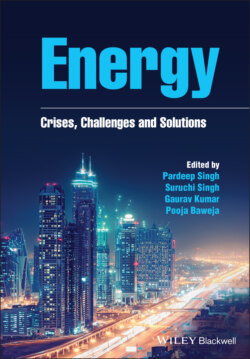Читать книгу Energy - Группа авторов - Страница 59
2.3.4 Geothermal Energy
ОглавлениеGeothermal energy is generated within the sub‐surface of earth in the form of heat. Direct use of this energy is for heating purposes (Lund and Boyd 2016), and/or it can also be harnessed for electricity generation using a geothermal power plant (Bertani 2016). Compared with the intermittent sources of energy (solar and wind), geothermal energy is constant around the year and it is available worldwide. Electricity generation from the geothermal energy comes with many benefits as compared with some other renewable energy sources such as higher capacity factors (>90%), flexibility in power production, ability of efficiently providing baseload electricity, low cost of electricity generation due to lower cost of operation, lower impact on environment along with less CO2 emissions and land usage is also small (Geirdal et al. 2015). Electricity production from geothermal has lower life‐cycle greenhouse gas (GHG) emissions as compared with fossil fuels (https://archive.ipcc.ch/pdf/special‐reports).
Despite many advantages of geothermal energy, its share in worldwide energy production is very small owing to many challenges such as substantial initial capital cost, longer time period before a geothermal plant becomes operational and high risk at early stage (pre‐survey, exploration and test drilling) (IRENA 2017). As mentioned earlier in Section 3, contribution of geothermal energy was 14 GW by the end of 2019 which is a relatively small percentage (<0.6%) of the total generation capacity of all the renewable sources of energy.
Geothermal energy has tremendous potential for development in near future owing to the huge amount of energy present within 10 km of the earth's surface which contains 50000 times more energy than all the fossil fuel reserves existing globally (Shere 2013, pp. 201). Depending upon the amount of heat present in a geothermal reservoir, different technologies are used for power generation. Medium or high‐temperature resources are required for power production which are generally located in the vicinity of tectonically active regions. To transfer the heat present within the earth's surface, water or steam is used. At present, four different technologies are used for power production from geothermal energy, namely dry steam plants, flash plants (single, double and triple), binary plants, and combined‐cycle or hybrid plants (Long et al. 2003). These technologies are based on exploitation of conventional geothermal resources.
Figure 2.3 Comparison of geothermal power capacity (MW) by different countries in 2016 and projected values in 2025 and beyond 2025.
Source: Based on data in Ref. (IRENA 2017).
Recently, due to more developments in enhanced geothermal systems (EGS), which are the deep geothermal resources, power production from these types of plants will add a new dimension in the geothermal energy sector. Power generation will increase by many folds and can reach to 70 GWe (installed capacity) by 2050 (Lu 2018). Figure 2.3 shows the geothermal power capacity of some countries in 2016 along with projected values in 2025 and ahead of 2025 (IRENA 2017).
